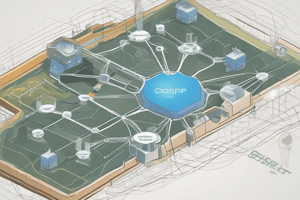Podcast
Questions and Answers
What are the two main types of routing protocols discussed?
What are the two main types of routing protocols discussed?
Distance Vector Routing and Link State Routing.
Which algorithm is commonly associated with Distance Vector Routing?
Which algorithm is commonly associated with Distance Vector Routing?
Bellman-Ford algorithm.
How often do routers using Distance Vector Routing typically send updates?
How often do routers using Distance Vector Routing typically send updates?
Every 30 seconds.
What is the primary difference in convergence time between Distance Vector and Link State Routing?
What is the primary difference in convergence time between Distance Vector and Link State Routing?
What is meant by the term 'vector' in Distance Vector Routing?
What is meant by the term 'vector' in Distance Vector Routing?
Which protocol is an example of Link State Routing?
Which protocol is an example of Link State Routing?
How many routing tables are typically used in Link State Routing?
How many routing tables are typically used in Link State Routing?
What resources are typically required for Link State Routing compared to Distance Vector Routing?
What resources are typically required for Link State Routing compared to Distance Vector Routing?
What is static routing and how is it configured in network devices?
What is static routing and how is it configured in network devices?
List two main advantages of static routing.
List two main advantages of static routing.
What are the disadvantages of static routing in large networks?
What are the disadvantages of static routing in large networks?
Define distance vector routing protocols and give an example.
Define distance vector routing protocols and give an example.
What differentiates link state routing protocols from distance vector protocols?
What differentiates link state routing protocols from distance vector protocols?
What is the role of the network layer in routing?
What is the role of the network layer in routing?
Why is knowledge of network topology important for static routing?
Why is knowledge of network topology important for static routing?
What IP configuration is applied to Router R1 and its interfaces?
What IP configuration is applied to Router R1 and its interfaces?
What is the purpose of configuring static routes on a router like R3?
What is the purpose of configuring static routes on a router like R3?
What addresses are used as next-hop addresses in R3's static route configuration for the 192.168.10.0 network?
What addresses are used as next-hop addresses in R3's static route configuration for the 192.168.10.0 network?
How is default routing configured for a stub router like R1?
How is default routing configured for a stub router like R1?
What is dynamic routing and how does it differ from static routing?
What is dynamic routing and how does it differ from static routing?
What are two examples of dynamic routing protocols mentioned in the content?
What are two examples of dynamic routing protocols mentioned in the content?
What is a significant advantage of using dynamic routing protocols?
What is a significant advantage of using dynamic routing protocols?
What potential disadvantage does dynamic routing have compared to static routing?
What potential disadvantage does dynamic routing have compared to static routing?
What command is used to configure default routing for R2?
What command is used to configure default routing for R2?
Flashcards
Routing
Routing
A process where the network layer of a device selects the best path to send a packet from one network to another.
Static Routing
Static Routing
A type of routing where network administrators manually configure routes on routers.
Advantages of Static Routing
Advantages of Static Routing
Advantages of static routing include minimal processing overhead, enhanced security, and no bandwidth consumption for routing updates.
Disadvantages of Static Routing
Disadvantages of Static Routing
Signup and view all the flashcards
Static Routing Configuration
Static Routing Configuration
Signup and view all the flashcards
Dynamic Routing
Dynamic Routing
Signup and view all the flashcards
Routing Protocols
Routing Protocols
Signup and view all the flashcards
Distance Vector Routing Protocols (DVRP)
Distance Vector Routing Protocols (DVRP)
Signup and view all the flashcards
Default Route
Default Route
Signup and view all the flashcards
Stub Router
Stub Router
Signup and view all the flashcards
RIP (Routing Information Protocol)
RIP (Routing Information Protocol)
Signup and view all the flashcards
OSPF (Open Shortest Path First)
OSPF (Open Shortest Path First)
Signup and view all the flashcards
Default Routing
Default Routing
Signup and view all the flashcards
Distance Vector Routing
Distance Vector Routing
Signup and view all the flashcards
Link State Routing
Link State Routing
Signup and view all the flashcards
Routing Table in Distance Vector Routing
Routing Table in Distance Vector Routing
Signup and view all the flashcards
Routing Table in Link State Routing
Routing Table in Link State Routing
Signup and view all the flashcards
Periodic Updates in Distance Vector Routing
Periodic Updates in Distance Vector Routing
Signup and view all the flashcards
Triggered Updates in Link State Routing
Triggered Updates in Link State Routing
Signup and view all the flashcards
Convergence Time in Distance Vector Routing
Convergence Time in Distance Vector Routing
Signup and view all the flashcards
Convergence Time in Link State Routing
Convergence Time in Link State Routing
Signup and view all the flashcards
Study Notes
Routing and Switching Overview
- The instructor is Dr. Saleem ullah from the Department of Computer Science, KFUEIT - Rahim Yar Khan.
- Topics covered include Routing Protocols and basic configuration, Distance Vector Routing Protocols (DVRP), DVRP Configuration, Link State Routing Protocols (LSRP), and LSRP Configuration.
Routing Protocols
- Routing is performed by layer 3 (network layer) devices, delivering packets by selecting an optimal path from one network to another.
- Types of Routing:
- Static Routing
- Default Routing
- Dynamic Routing
Static Routing
- Static routing involves manually adding routes to the routing table.
- Advantages:
- Low CPU overhead for the router
- Enhanced security, as only administrators can configure routes to specific networks.
- No bandwidth consumption between routers.
- Disadvantages:
- Difficult for large networks, requiring manual configuration of each route on every router.
- Requires in-depth knowledge of the network topology.
Static Routing Configuration
- Example configurations are provided for routers R1, R2, and R3, specifying IP addresses and network routes.
Default Routing
- Default routing configures the router to send all packets to a single router (next hop) regardless of the destination network.
- This is commonly used with stub routers, which have only one route to reach all other networks in the topology.
- Example configurations are provided for routers R1 and R2, setting up default routes.
Dynamic Routing
- Dynamic routing automatically adjusts routes based on the current network state, leveraging protocols to discover destinations and optimize paths.
- Protocols like RIP (Routing Information Protocol) and OSPF (Open Shortest Path First) are common examples.
- Advantages:
- Easier configuration for large networks
- Efficient route selection
- Disadvantages:
- Increased bandwidth consumption for communicating with neighboring routers.
- Lower security compared to static routing.
Distance Vector Routing vs Link State Routing
- Key differences between distance vector (e.g., RIP) and link-state (e.g., OSPF) protocols are highlighted:
- Routing Table Structure (complete vs. partial)
- Update Mechanisms (periodic vs. event-driven)
- Convergence Time (slower vs. faster)
- Resource Utilization (less vs. more)
Distance Vector Routing Details
- RIP is a distance-vector protocol, the simplest to implement.
- Distance is measured in hops, and the vector indicates the direction to the next router.
- Routing tables are exchanged periodically, allowing routers to learn about network distances and paths.
Studying That Suits You
Use AI to generate personalized quizzes and flashcards to suit your learning preferences.




